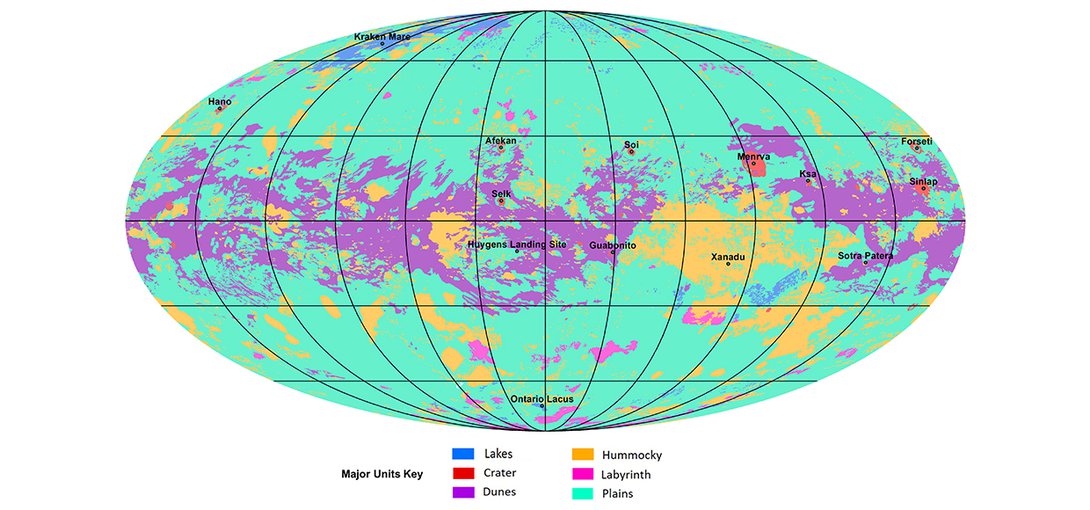Key takeaways
- Scientists have created the first-ever global geological map of Saturn’s moon Titan using data from NASA’s Cassini mission. This map, at a scale of 1:20,000,000, highlights six key geological features, including lakes, plains, and dunes.
- Titan has become a key focus for astrobiology research due to its dynamic methane-based hydrological cycle, which resembles processes seen on Earth. Despite vast differences from Earth, studying Titan provides insights into geological processes on our own planet.
- The Cassini spacecraft, during its mission from 2004 to 2017, provided crucial data by penetrating Titan’s thick atmosphere, revealing previously unseen geological features. This data was used to classify and map Titan’s geological units.
- Titan is rich in organic materials, particularly hydrocarbons, which are deposited across its surface through erosion and other processes. The newly created map shows vast plains and dunes covered in hydrocarbon material.
- The Titan geomorphological map serves as a foundation for future missions, such as NASA’s Dragonfly, which will explore Titan’s surface in detail. Scheduled to launch in 2026, Dragonfly will arrive at Titan in 2034, advancing our understanding of this intriguing moon.
A new research, funded in part by the NASA Astrobiology Program, has produced a worldwide geomorphological map of Saturn’s moon Titan based on Cassini data. The globe map is 1:20,000,000 scale and depicts six key geological units: lakes, hummocky terrain, craters, labyrinth terrain, plains, and dunes.
Titan is now a top priority for astrobiology study in our solar system. An dynamic methane-based hydrological cycle shapes the moon’s surface, which has characteristics similar to those seen on Earth. Despite the significant variations in temperature, gravity, and materials between Titan and Earth, the moon can give an opportunity for comparative planetology, allowing scientists to better comprehend geological processes on our planet.

When the Cassini spacecraft approached Titan, it was able to peek through the moon’s thick, hazy atmosphere and uncover previously hidden geological features. A team of academics has now created a global map using Cassini data to better contextualize these characteristics. The researchers classified and mapped six key geological units using Cassini’s synthetic aperture radar (SAR). The researchers then linked SAR with other datasets to fill up the gaps where SAR data was not available. This includes information from both the Imaging Science Subsystem (ISS) and the Visible and Infrared Mapping Spectrometer (VIMS).
Cassini data previously demonstrated that Titan is rich in organic stuff in the form of hydrocarbons discovered on its surface. Hydrocarbon material is transported and deposited about the moon by processes like as erosion, and it may be found covering most of Titan’s surface, including the enormous plains and dunes seen in the newly created map. Titan’s plains are predicted to encompass up to 65% of the world surface.
The new Titan map illustrates the links between the major geological divisions, helping researchers to get a better understanding of the processes that produced Titan’s surface and how the terrain has changed over time. The graphic shows that Titan is dominated by sedimentary or depositional processes, which eventually produce in enormous areas of dunes and plains. Variations can also be recognized by latitude, with sand regions at the equator, plains in the middle latitudes, and lakes and labyrinth terrains at the poles.
The Titan geomorphological map is a step toward a more complete knowledge of the moon’s surface, which is critical in the construction of new astrobiology-related missions to the Saturn system. NASA’s Dragonfly mission will be the next to visit Titan, sampling and examining several areas on the moon’s surface. Dragonfly is presently under development and will launch in 2026, arriving at Titan in 2034.
The study, “A global geomorphologic map of Saturn’s moon Titan,” appeared in the journal Nature Astronomy. The NASA Astrobiology Institute (NAI) component of the NASA Astrobiology Program provided some funding for this research. This research is an important element of NASA’s efforts to comprehend the Universe, expand human exploration, and inspire future generations. As NASA’s Artemis program goes forward with human lunar exploration, the agency continues to prioritize the hunt for life on other planets.
Additional Resources:
A whole new world: astronomers draw first global map of Titan (Nature)
NASA Announces Astrobiology Mission to Titan (Many Worlds)
NASA Selects Flying Mission to Study Titan for Origins, Signs of Life (NASA)

